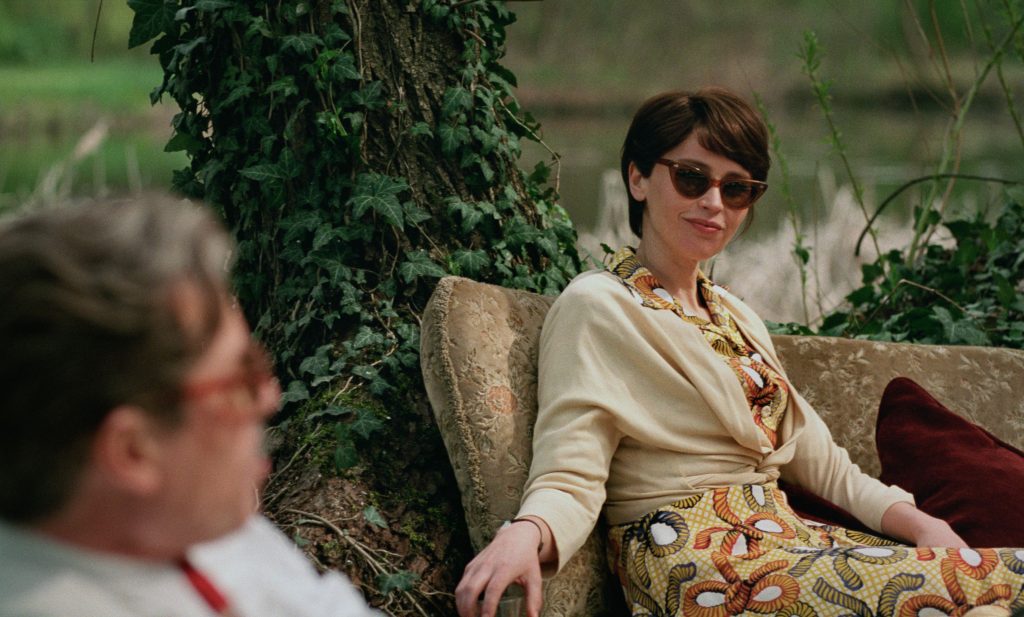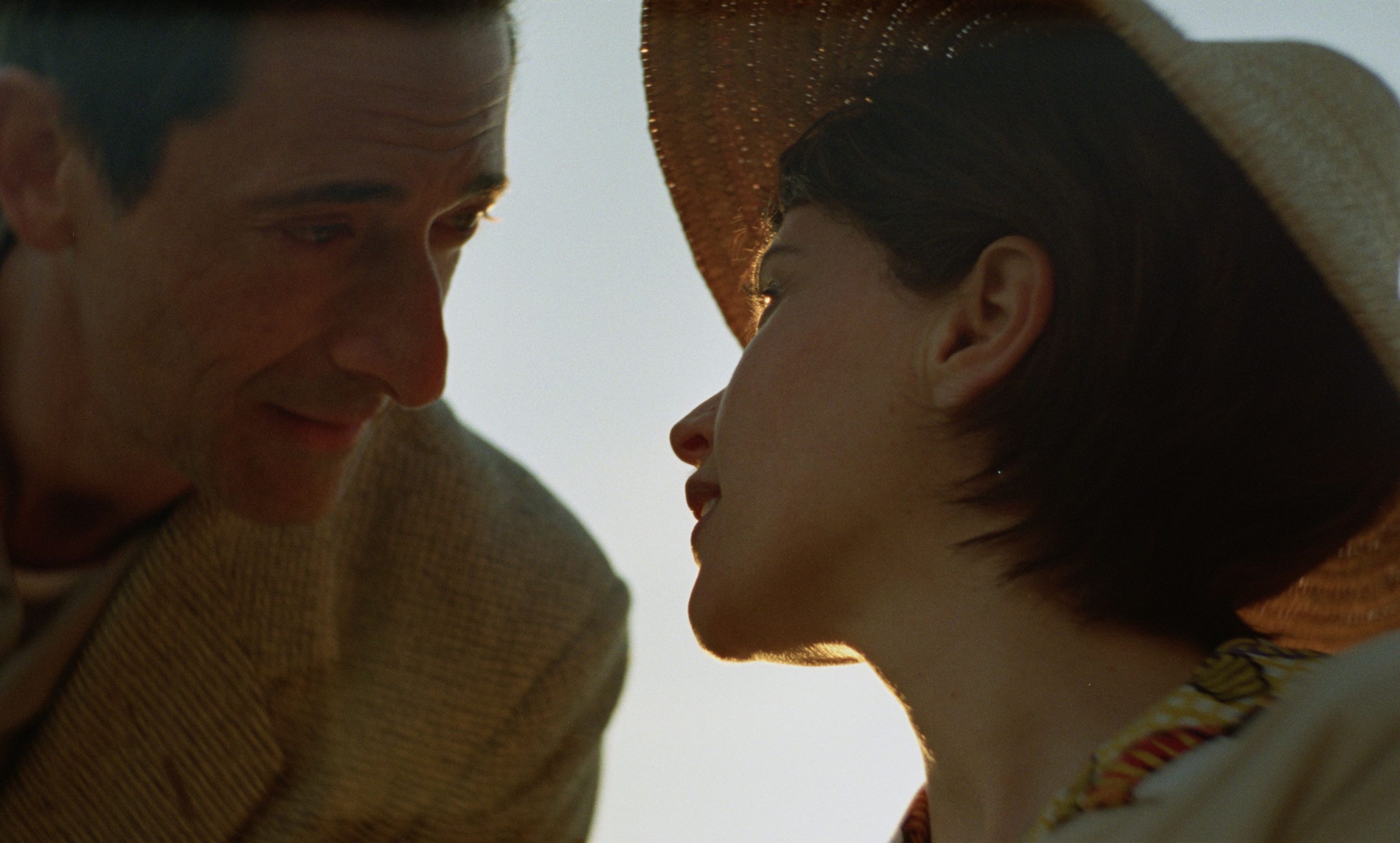In a cinematic landscape dominated by formula and spectacle, Brady Corbet’s sprawling three-and-a-half-hour epic “The Brutalist” stands as a defiant monument to ambitious filmmaking—a rare modern work that dares to examine the complex intersections of art, trauma, and the American immigrant experience with the kind of scope and vision rarely seen in contemporary cinema.
Quick Summary Box
| Category | Details |
|---|---|
| Movie Name | The Brutalist (2024) |
| Director | Brady Corbet |
| Cast | Adrien Brody, Felicity Jones, Guy Pearce, Joe Alwyn |
| Genre | Drama, Historical, Epic |
| IMDb Rating | 8.3/10 ⭐ |
| Duration | 3h 30m |
| Where to Watch | In theaters (limited release) |
| Release Date | September 6, 2024 (Venice), October 4, 2024 (US) |
Introduction: A Towering Achievement in Cinematic Ambition
“The Brutalist” marks the culmination of Brady Corbet’s evolution from actor to auteur, cementing his place as one of the most daring American filmmakers working today. Following his previous directorial efforts “The Childhood of a Leader” and “Vox Lux,” Corbet has crafted his most ambitious work yet—a sprawling, decades-spanning chronicle of Hungarian Jewish architect László Toth (Adrien Brody) and his journey through post-WWII America. Winner of the Silver Lion at the 2024 Venice Film Festival, “The Brutalist” is a work of staggering formal ambition and emotional intensity that demands to be experienced on the largest screen possible.
Plot: An Architectural and Personal Odyssey
The film follows László Toth, a brilliant Hungarian Jewish architect who survives the Holocaust and immigrates to America in 1947 with his wife Erzsébet (Felicity Jones). Arriving with little more than his talent and trauma, László struggles to establish himself in a country simultaneously offering opportunity and xenophobia. His fortunes change when he meets eccentric industrialist Harrison Lee Van Buren (Guy Pearce), who commissions László to design a grand monument that will serve as his legacy.
Spanning three decades (1947-1977), the narrative unfolds in three distinct acts, each filmed in different aspect ratios and visual styles to reflect László’s evolving relationship with America and his own traumatic past. As László’s architectural vision takes physical form, his personal life unravels—his marriage to Erzsébet deteriorates under the weight of shared trauma and unfulfilled dreams, while his relationship with Van Buren evolves from patronage to friendship to bitter rivalry.
The central architectural project becomes a metaphor for László’s own fractured psyche—a brutal, imposing structure that seeks to reconcile beauty with functionality, the past with the future, and Old World sensibilities with American innovation. As László pours his soul into his creation, the film explores the cost of artistic ambition, the immigrant experience in post-war America, and the impossible task of creating something permanent in an impermanent world.
Performance Analysis: Brody’s Tour de Force
At the center of “The Brutalist” is Adrien Brody’s towering performance as László Toth, perhaps the most significant role of his career since “The Pianist.” Brody physically transforms throughout the film’s three-decade span, but more impressive is his ability to convey László’s internal evolution—from hopeful immigrant to celebrated architect to embittered genius. Speaking in a meticulously researched Hungarian accent that never slips into caricature, Brody captures both László’s intellectual brilliance and his emotional fragility, creating a character whose artistic vision is inseparable from his personal trauma.
Felicity Jones delivers a haunting performance as Erzsébet, László’s wife who carries her own profound trauma from the Holocaust. Jones navigates Erzsébet’s journey from supportive spouse to disillusioned partner with subtle precision, her quiet moments often speaking volumes more than her dialogue. The chemistry between Brody and Jones convincingly portrays a relationship built on shared history and pain, making their eventual estrangement all the more devastating.
Guy Pearce brings nuance and unexpected depth to Harrison Lee Van Buren, avoiding the easy characterization of the wealthy patron as either savior or villain. Instead, Pearce creates a complex figure whose genuine appreciation for László’s genius is complicated by his own ego and the inherent power dynamics of their relationship. The scenes between Brody and Pearce crackle with intellectual energy and unspoken tension, forming the emotional backbone of the film’s exploration of art and patronage.
Visual Storytelling: A Formal Masterpiece
Cinematographer Lol Crawley delivers some of the most striking imagery in recent cinema, with each of the film’s three acts employing distinct visual languages. The 1940s sections are shot in boxy 4:3 aspect ratio on 16mm film, evoking both the period’s cinema and the claustrophobic limitations of László’s early American experience. The 1950s expand to 1.85:1 in 35mm, reflecting László’s growing opportunities and creative freedom. The final act, set in the 1970s, opens into breathtaking 65mm widescreen compositions that showcase the monumental scale of László’s architectural achievement while paradoxically highlighting his growing isolation.
Corbet’s direction demonstrates remarkable restraint and confidence, allowing scenes to unfold at a deliberate pace that rewards patient viewers. His camera often holds on faces longer than conventional editing would dictate, finding meaning in microexpressions and silences. The film’s centerpiece sequence—a seven-minute unbroken take that follows László through his completed structure as he experiences it for the first time—is a breathtaking marriage of performance, cinematography, and production design that encapsulates the film’s themes without a word of dialogue.
The production design by Jean-Vincent Puzos is nothing short of extraordinary, creating a believable architectural evolution from initial sketches to finished monument. The brutalist structure itself becomes a character in the film—imposing, controversial, and ultimately transcendent in its raw concrete beauty.
Thematic Richness: Building Monuments From Trauma

“The Brutalist” operates as a multifaceted exploration of several interconnected themes:
Art and Trauma: The film examines how artistic creation can serve as both expression of and escape from personal trauma. László’s architectural vision—characterized by exposed materials and uncompromising forms—directly reflects his experiences during the Holocaust and his struggle to reconcile his European heritage with American opportunity.
Immigrant Experience: Through László’s journey, the film offers a nuanced portrait of post-war America’s complicated relationship with European immigrants, particularly Jewish refugees. The country simultaneously offers opportunity and prejudice, acceptance and alienation, creating a persistent sense of displacement that shapes László’s work and worldview.
Creation and Destruction: The film explores the tension between the human desire to create lasting monuments and the inevitable forces of time, nature, and human conflict that threaten to destroy them. László’s architectural ambition is portrayed as both noble and futile—a rage against mortality that ultimately cannot escape it.
Power and Patronage: The evolving relationship between László and Van Buren serves as a microcosm for examining the complex dynamics between artistic vision and financial backing. The film asks uncomfortable questions about who ultimately “owns” art and how economic power shapes creative expression.
Cultural Impact: A Return to Ambitious Filmmaking
“The Brutalist” arrives at a time when mainstream American cinema has largely abandoned the kind of ambitious, formally daring, adult-oriented dramas that dominated the 1970s. Its Venice Film Festival reception—where it received an eight-minute standing ovation and the Silver Lion—suggests a hunger for cinema that challenges audiences while rewarding their attention.
Critics have drawn comparisons to the work of directors like Terrence Malick, Stanley Kubrick, and Paul Thomas Anderson, positioning “The Brutalist” as part of a tradition of American filmmaking that treats cinema as a serious art form capable of tackling complex ideas and emotions. Its visual language and thematic preoccupations also connect it to European art cinema, particularly the work of Ingmar Bergman and Michelangelo Antonioni.
The film’s unflinching exploration of the post-war immigrant experience also resonates with contemporary discussions about immigration, cultural identity, and the American Dream, making its historical setting feel urgently relevant to current social and political debates.
The Film’s Legacy: A Monument to Cinematic Ambition
While “The Brutalist” has only recently been released, its formal ambition and thematic depth position it as a potential landmark in early 21st-century American cinema. By embracing an epic runtime, challenging narrative structure, and visual experimentation, Corbet has created a work that demands to be experienced on its own terms rather than conforming to commercial expectations.
For Corbet himself, the film represents a significant leap forward in his directorial career, establishing him as a filmmaker of rare vision and ambition. For Brody, it offers a role that makes full use of his considerable talents, potentially joining “The Pianist” as a defining performance in his filmography.
Whether “The Brutalist” will find a wide audience remains to be seen, but its artistic achievement ensures its place in the conversation about significant contemporary American cinema. Like the architectural movement from which it takes its name, the film may polarize audiences with its uncompromising vision, but those willing to engage with its scope and ambition will find rewards that more conventional filmmaking rarely offers.
Conclusion: A Monument Worth Experiencing
“The Brutalist” is not a film that can be casually consumed—it demands attention, patience, and emotional investment from its audience. Its three-and-a-half-hour runtime might seem daunting, but like the great architectural works it celebrates, the film rewards those willing to engage with its scale and ambition.
In an era of entertainment increasingly designed for easy consumption, Corbet has created something deliberately challenging—a work that believes in cinema’s power to explore the deepest aspects of the human experience through the specific lens of one man’s creative journey. Whether viewed as a character study, a meditation on art and trauma, or a visual feast, “The Brutalist” stands as one of the most significant American films of recent years.
For those willing to surrender to its vision, “The Brutalist” offers a rare cinematic experience—challenging, occasionally difficult, but ultimately transcendent in its ambition and execution. Like the imposing concrete structures that inspired its title, the film’s rough edges and uncompromising vision may initially alienate some viewers, but its lasting impact is undeniable.
If you’ve experienced Anora and appreciated its bold independent vision, “The Brutalist” offers another example of American cinema at its most ambitious and uncompromising—a film that, like its protagonist, refuses to conform to expectations and instead creates something truly monumental.
Did You Know?
- Brady Corbet spent seven years developing the project before securing financing
- The film uses three different film stocks (16mm, 35mm, and 65mm) to visually distinguish its three time periods
- Adrien Brody spent six months learning architectural drawing and Hungarian language basics for the role
- The brutalist structure featured in the film was partially constructed as a practical set rather than relying entirely on CGI
- The film’s score, composed by the late Jóhann Jóhannsson and completed by his collaborators after his death, was recorded with a 120-piece orchestra
Where to Watch
Currently in limited theatrical release, with wider release planned for October 2024. Streaming availability to be announced.
If You Enjoyed “The Brutalist,” You Might Also Like:
- “There Will Be Blood” (2007) – Another epic exploration of ambition and the American landscape
- “The Immigrant” (2013) – James Gray’s period drama about the immigrant experience in early 20th century America
- “The Tree of Life” (2011) – Terrence Malick’s ambitious meditation on family, nature, and existence
- “Synecdoche, New York” (2008) – Charlie Kaufman’s surreal exploration of artistic ambition and monument-building

1 thought on “The Brutalist (2024) Review: A Monumental Architectural Odyssey of Trauma and Redemption”